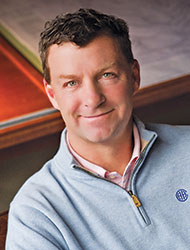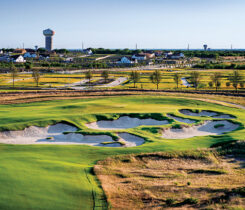A conversation with Architect Gil Hanse continued

Headshot: Gil Hanse
Gil Hanse, the architect hired to construct the 2016 Olympic course in Rio de Janeiro, sat down for a conversation with us not too long ago. Our September cover story, The Golden Touch: A conversation with Architect Gil Hanse, could only highlight a portion of Hanse’s answers. In this extended version, Hanse discusses the delays to the course in Rio, how he handles criticism and his hope for the future of his design company.
Golfdom: Gil, thanks for taking the time. I know you must get asked this ten times a day, but what is the latest on your course in Rio de Janeiro?
Hanse: My pleasure. We finally have irrigation turning, it is installed on 16 holes at present and we have grass on ten greens and six holes completely grassed.
All 18 holes are shaped, we finished shaping the last hole in March so they are all ready to go. It’s just the function of getting the irrigation in the ground and then allowing us to start doing finishing work, which is progressing nicely under the supervision of Neil Cameron, Kyle Franz and Ben Warren from our team.
We’ll try to wrap up by November, which gets us to a point that will give them two summers to grow it in. Their summer is opposite ours. If we get grass on the ground in November, that will that will give them the summers of ’14 and ’15, and then ’15 and ’16 to have it grown in. It is critical we get grass on the ground for the coming summer.
Golfdom: Neil Cleverly was hired as the superintendent for the project. How did he get that job? Did you know him previously?
Hanse: I know him very well now, we have been going through the battle together. You know, he is ex-military so he understands what that means.
We didn’t meet him until after he was selected. He was interviewed at the GCSAA show in San Diego, which I did not attend because I was living in Rio at the time. Jim Wagner (vice president/design partner) from our company went down and was part of the team to interview him. By all accounts Neal did a great job, he’s got a ton of experience overseas, primarily with warm season grasses, which was a bonus. Although he doesn’t have experience with Zeon zoysia, which is the primary grass on-site, he’s well equipped to deal with it and he has been a Godsend.
During the early parts of construction it was basically myself and a couple guys who work with me down there. We were trying to make our way through the myriad complexities of the project. Working without a project manager, trying to make sense of it all and then when Neal showed up last August he immediately took over as project manager because obviously there was no turf. He got very involved in the earth moving and showed the amount that he could bring to the project. He was not only a great turf manager, but also an excellent project manager from the construction standpoint. So he has been the rock of the construction part of the project.
Golfdom: Give me an update on what other projects you’re working on now.
Hanse: We are just finishing up at Winged Foot. We restored, renovated the front nine on the east course. I went out to Denver last week for two days, Chris Swim is the superintendent at Lakewood CC. He has been a friend of mine for 20-plus years and Lakewood was the first club that ever hired us, after I left Tom Doak. I just flew out there to shape two bunkers.
I’m headed to Dubai on Sunday, we are building a course for Donald Trump. Then I’ll be down in Mississippi, Starkville area, doing a practice facility for Mississippi State University, and then after we finish that we will start a new 18-hole golf course there that’s a private club close to Mississippi State. Then back to Rio.
We are very fortunate; we have a lot of stuff going on. Some stuff is coming down the pike that we haven’t locked up yet, but it’s really promising.
Golfdom: Talk to me about your philosophies with working with superintendents. When do you like to see them get involved with construction projects you do?
Hanse: The most humbling thing for a golf architect — and most of us aren’t very humble by nature — at the end of the day only about 5 to 10 percent of golfers really appreciate the design, understand strategy and risk/reward and really analyze golf courses that way. But 99 percent of golfers appreciate good turf conditions. From that standpoint, the most important person on the project from the public perception is the superintendent. And we absolutely embrace that and understand it.
I think when you have a great golf course and a great product is when there is a combination of excellent design and excellent maintenance. Then I think everybody at a certain level understands it. “Ok, wow, it was fun to play, it was interesting and it was obviously well-maintained.” So from that standpoint, you really can’t overestimate the importance the superintendent has on the project. We can have all the philosophy and thoughts about what we design and how the golf course should play and how strategies should work out, but if the maintenance doesn’t match up then it’s all for nothing.
It’s critical to have superintendents involved from day one, and as soon as construction starts. They should be on-site because there should always be (maintenance) conversations going on. ‘What are you thinking? What are we looking for here? How can we maintain this? How can we present it? Ok great you want it firm and fast, let’s get some sand in the approaches. Let’s really start to look at top dressing and manicuring and taking care of approaches the same way we take care of greens.’
That’s going to be part of what we want so superintendents know what they need (to plan for in the) budget. Presentation of the golf course, presentation of bunkers, hazards, you know we need to talk about green speeds because obviously the greens and the slopes need to relate to what the intentions of the ownership and the abilities of the superintendents are.
I think there are all these critical linkages that occur between design and maintenance, if you can have that team in place from day one, then your construction is going to be better. Your approach to maintaining and keeping soil structure is going to be better. You ultimately give them the opportunity to grow better turf. You are working with the person that you want to make sure believes and understands the philosophy of what you are trying to create.
It has been my experience that on projects, renovation and restoration projects, your superintendent is your biggest advocate at the club. So that relationship is critical.
Golfdom: It’s hard to ask someone to describe their style, it’s like asking someone to describe art. And yet I want to ask… Does Hanse Golf Course Design have a style?
Hanse: Well, we give the trade answer ‘I hope we don’t have a style,’ and it doesn’t sound sincere. But it’s true, obviously there are trademarks to our work, you know (vice president/design partner) Jim Wagner and I believe that the golf course we are building should look like it belongs in that landscape. So our golf course in Boston is not going to look like our golf course in Rio.
We utilize the indigenous vegetation that’s going to be in that area, the certain types of turf grasses. The consistent theme through our work is that they feel natural, they feel as if they are a part of that site, part of that landscape. I guess our style would be that we work really hard to try to preserve and maximize the natural advantages that a site gives you. By doing that we sort of defeat having a style.
I think if you bring that approach of trying to maximize the natural advantages, you are going to make your golf courses more unique from site to site. (Courses) will reflect the positives that site has. And if we can get the vegetation and the grassing to match the site, then we’ve done our job.
Golfdom: What has getting the Olympics course done for your career?
Hanse: It has been a big positive; it has made us a known commodity in our industry. There is a recognition that comes along with it. We are obviously humbled and honored by the opportunity. I think the golf world, in this sort of small world that we all work and live in, we were a known commodity because of the quality of work.
We are humbled and honored by the opportunity. It’s helped us a lot, but we are tying not to let it change who we are and how we work. We still want to remain intentionally small and still focused. My favorite part of the job is getting onto a bulldozer and shaping. I think if I lose that then I think we’ve lost the battle as opposed to being able to stay focused on what is important.
Golfdom: How did you find out you got the Rio job?
Hanse: The Golf Channel concocted this grand charade. They told me that they were sending camera crews to be with all eight of the finalists. They wanted to film (the phone call) because they are doing a documentary, they wanted to see the reactions of the people who didn’t get it and the one person who did get it. So they asked Jim Wagner and I, we were at Doral, we had just been signed to do the renovation there. So they asked us to come down at 6:30 in the morning to wire Jim and I up.
Tracy, my wife, and Chelsea, our oldest daughter, were there. We were all sitting on the couch and the phone call was supposed to come at 7 a.m. So 7 a.m. passes, 8 passes, 9 passes, and then 10 comes and by this time Jim Wagner, who is one of the funniest guys you will ever meet, is being merciless with the crew. He asks ‘Are you guys kidding me!’ and I am cleaning that up.
We had been sitting there for three and half hours and then I noticed this guy standing over in the corner texting. Finally at 10:20 my phone rings and here everybody jumps with the tension, and it is somebody else. At 10:30 the call comes, it’s the people in Rio, “Gil you’ve got the job,” and I am like, “Oh my God, this is great,” and the mystery person leaves. Tears and kisses and hugs and all that kind of stuff. Anyways, come to find out later that they were the only camera crew, they knew that we were going to get it. The call was supposed to come from Rio, but they didn’t have my cell phone number. The guy texting over in the corner was Mike McCarly, the CEO of Golf Channel. He texted my cell phone number to the people in Rio so they could call us. It was kind of a funny, a long morning I will tell you that, but very exciting news when it finally came.
Golfdom: Why do you think they picked you?
Hanse: You know nobody has ever told me directly, I sort of heard through the grapevine, two things; that our presentation was excellent, we really did a good job delivering the message when we had to deliver it to the group. Secondly was our commitment to move there and live there and none of the other architects were either able based on schedule, or life, or whatever, to do it. So I think that really separated us.
Golfdom: What would be your storybook ending for you and your team for the Olympics?
Hanse: The storybook ending would be that the golf course is well received but it’s not the main part of the story, the story is that there is great competition and whoever plays for the gold medal, that the golf course was a great stage to create drama for that finish.
If the golf course is the main story that probably means that something went wrong. If they are all talking about the golf course, generally speaking that’s not a good thing. So I’d rather the story mainly be about the competition and we built something that was able to host a really great competition.
Golfdom: How many times in a week are you asked about the progress in Rio? How much has your life changed with the media attention?
Hanse: I’ll tell you this: we turned “What’s going on in Rio?” into a drinking game.
We obviously would like to be a lot further along than we are, and if we had been given the resources and the people down (in Rio) had followed directions that we were giving… we’d be done and they’d be the heroes of Rio because the golf course would be the only thing that is actually finished.
From that standpoint it has been frustrating. It has been a little bit difficult to try to manage this extended timeline because we have a lot of existing clients that were extremely understanding and very proud of the fact that we are building the Olympic golf course. You know we told everybody, ‘listen, 2013 we are gone, we are going to be focused on that and not going to be able to spend a lot of time,’ and everybody was great.
Now that it’s going to be most of 2014, you can’t keep putting people off. So I think the biggest stress has been just trying to honor all of the commitments that we had made, things that we had to delay and still provide the attention that is required for a golf course of this magnitude. That’s really been where the gray hairs have come from.
I still think sometimes that it’s funny that people think my opinion is important in certain instances. You know from that standpoint I don’t think that this is a burden at all. We are really lucky that people are seeking us out and wanting to talk to us and are interested in what we have to say.
Golfdom: How do you handle critics?
Hanse: You know we take a lot of pride in what we build and we spend a lot of time on each project. I don’t believe for a second any architect or any designer that says ‘oh, I don’t care about that, we did what we wanted to and that’s fine.’ At the point, I don’t think you care enough about what you do.
I think we definitely get stressed about it, but it’s generally an excitement. Then when we take in the feedback, we listen to it, but I don’t let it tear me apart, nor does Jim. Some of it is just unfounded. It’s like ‘alright, they just didn’t get it.’ If there are things that come across as well-intentioned from the Tour players then yeah, you take that and you use it as constructive criticism as opposed to something that was messed up or flawed.
Golfdom: From where you first started out to where you are now, is it like you thought it would be?
Hanse: It is as we had hoped it would be. We’ve had a great mentor in Tom Doak. He was tremendously helpful in teaching me things that I needed to know and I understand his methodology, which he learned from Pete Dye. There were a lot of great connections I made and a lot of thing I learned from Tom. And then when it was time for me to go my own way and start my company, I think the work ethic we showed, the commitment again to being small and being focused on individual projects and you know the talents I was able to bring on board — Rodney Hine, Jim Wagner, Bill Kimmelman — (helped). We’ve always tried to keep things fun and we’ve always tried to keep things focused on quality.
So when you do that, you build slowly, because your name is not everywhere and there just are not a lot of examples of your work out there. I think a lot of the contacts we made helped to propel us to get better jobs. The thing we have to be weary of is that we don’t try to cash in and all of sudden get too big and get too spread out and the quality diminishes. I think that eventually catches up to you.
We also understand that right now, amongst a few others, we are sort of the hot architects and that’s going to change to other guys. Eventually we won’t be the hot guys, but the critical thing for us is to build enough work and show enough quality that we’re always relevant and we are always part of the equation even if we are not the top of the pile. We just want to always still have the opportunity to build and work on great projects.










